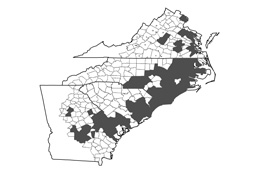![]()
<< Back :: Virginia :: North Carolina :: South Carolina :: Georgia :: FWGNA Home ::
![]()
<< Back :: Virginia :: North Carolina :: South Carolina :: Georgia :: FWGNA Home ::
> Amnicola limosa (Say 1817)
> Habitat & Distribution
Amnicola limosa is widespreadthroughout eastern North America, from Canada to Florida, ranging atleast as far west as Utah (Berry 1943). Populations are typicallyfound in lentic environments. In Atlantic drainages of the southeastern United States, A. limosa is most commonlycollected in the slow-moving rivers and swamps of the coastal plain,often onwoody debris. Such waters are often darkened by highconcentrations of organic compounds, but are not necessarily acidic.
> Ecology & Life history Several excellent studies have been directed toward the biology of A. limosa populations inhabitingnorthern lakes and ponds. Amnicolapopulations appear to be efficient grazers of diatoms and otherperiphyton (Kesler 1981, Cattaneo & Kalff 1986). They in turnmay be eaten by crayfish (Lewis 2001) and sunfish (Osenberg 1989,Bronmark et al 1992)
Several excellent studies have been directed toward the biology of A. limosa populations inhabitingnorthern lakes and ponds. Amnicolapopulations appear to be efficient grazers of diatoms and otherperiphyton (Kesler 1981, Cattaneo & Kalff 1986). They in turnmay be eaten by crayfish (Lewis 2001) and sunfish (Osenberg 1989,Bronmark et al 1992)
Populations generally appear to be annual and semelparous (cycle A of Dillon 2000: 156 – 162). But dynamics appear to be sensitive to aspects of water chemistry,especially hardness and pH (Shaw & Mackie 1989, 1990).
> Taxonomy & Systematics
By comparison to other hydrobiid taxa, systematic relationships haveremained relatively stable in the genus Amnicola (Berry 1943, Hershler& Thompson 1988). Amnicolalimosa may be confused with several other local hydrobiid taxaof equally vanilla shell morphology. The essay referenced belowcontains a link to a comparative photo that may be helpful in thisregard.
> Supplimentary Maps & Resources [PDF]
> Essay
My 26May04 essay on Somatogyrusalso included notes on Amnicolaand a couple photos.
Robert T. Dillon, Jr.
Department of Biology, College ofCharleston
Charleston, SC 29424
P: 843.953.8087
F: 843.953.5453